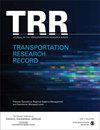Integrated Scheduling of Automatic Guided Vehicles and Automatic Stacking Cranes in Automated Container Terminals Considering Landside Buffer Zone
IF 1.8
4区 工程技术
Q3 ENGINEERING, CIVIL
引用次数: 3
Abstract
The enhancement of the efficiency of automated container terminals (ACTs) and promotion of energy saving and emission reduction have attracted increasing attention in the construction of resource-saving and environment-friendly ports. In this paper, an integrated scheduling optimization model of automatic guided vehicles (AGVs) and automatic stacking cranes (ASCs) is proposed to resolve the problem of long round trips and high energy consumption of ASCs in typical ACTs. The configurations of ACTs considering the landside buffer zone were analyzed. First, the feasibility of integrated scheduling when considering a landside buffer zone is introduced. The study also analyzes the problems that must be resolved for the integrated scheduling of AGVs and ASCs using the aforementioned layout handling technology. Subsequently, a multi-objective optimization model for the integrated scheduling of AGVs and ASCs considering the landside buffer zone was developed. In this model, the operations of AGVs and ASCs are divided into four categories: load transport, no-load transport, load/unload, and waiting. The objective of formulating the model was to minimize the makespan and total energy consumption. Finally, an improved non-dominated ranking genetic algorithm, NSGA-II, is employed to optimize the model. The results show that the makespan and total energy consumption of the integrated scheduling of AGVs and ASCs considering the landside and seaside buffer zones are better than those considering only the seaside buffer zone.考虑陆边缓冲区的自动化集装箱码头自动导引车与自动堆垛起重机综合调度
自动化集装箱码头效率的提高和节能减排的推进日益受到资源节约型、环境友好型港口建设的关注。针对自动导引车(agv)和自动堆垛起重机(ASCs)在典型ACTs中往返路程长、能耗高的问题,提出了一种自动导引车和自动堆垛起重机(ASCs)的综合调度优化模型。分析了考虑陆侧缓冲区的ACTs的配置。首先,介绍了考虑陆边缓冲区时综合调度的可行性。研究还分析了采用上述布局处理技术实现agv和asc综合调度必须解决的问题。在此基础上,建立了考虑陆侧缓冲区的agv和ASCs综合调度的多目标优化模型。在该模型中,agv和asc的操作分为四类:载运、空载、装卸和等待。制定模型的目的是最小化完工时间和总能耗。最后,采用改进的非支配排序遗传算法NSGA-II对模型进行优化。结果表明:考虑陆边和滨海缓冲带的agv和ASCs综合调度的最大跨度和总能耗优于仅考虑滨海缓冲带的agv和ASCs综合调度。
本文章由计算机程序翻译,如有差异,请以英文原文为准。
求助全文
约1分钟内获得全文
求助全文
来源期刊

Transportation Research Record
工程技术-工程:土木
CiteScore
3.20
自引率
11.80%
发文量
918
审稿时长
4.2 months
期刊介绍:
Transportation Research Record: Journal of the Transportation Research Board is one of the most cited and prolific transportation journals in the world, offering unparalleled depth and breadth in the coverage of transportation-related topics. The TRR publishes approximately 70 issues annually of outstanding, peer-reviewed papers presenting research findings in policy, planning, administration, economics and financing, operations, construction, design, maintenance, safety, and more, for all modes of transportation. This site provides electronic access to a full compilation of papers since the 1996 series.
 求助内容:
求助内容: 应助结果提醒方式:
应助结果提醒方式:


